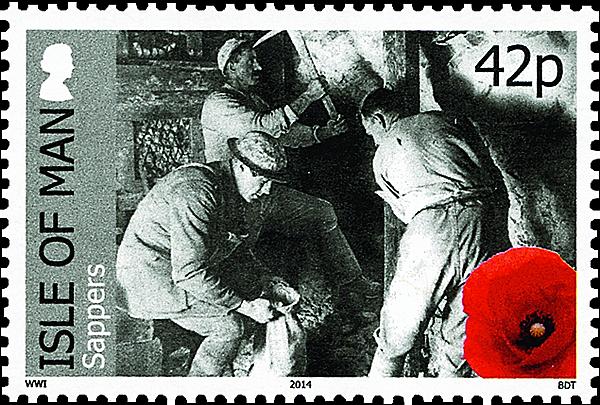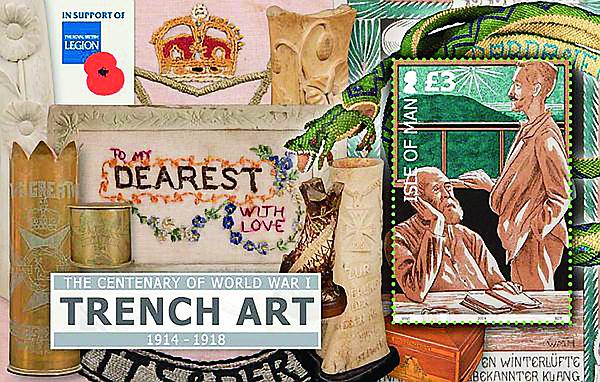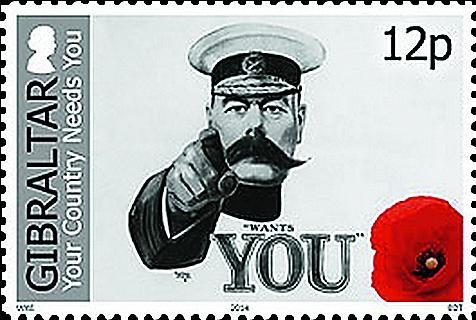World Stamps
Gibraltar and Isle of Man sets picture scenes of World War I
Gibraltar and the Isle of Man issued similar sets of stamps in February commemorating the 100th anniversary of World War I.
Gibraltar’s Feb. 9 set features preparations for war, and the Feb. 19 set from Isle of Man focuses on trench warfare.
The designs show black-?and-white photographs with a red poppy in the lower right corner. The first flower to bloom on the devastated battlefields of Belgium, France and Gallipoli, the poppy serves as an emblem of the war.
The 12-penny stamp from Gibraltar pictures a detail of the 1914 “Your Country Wants You” recruitment poster featuring Horatio Herbert Kitchener, the British secretary of war, pointing his finger. Figure 1 shows the stamp.
According to Great Britain’s National Portrait Gallery, Alfred Leete designed the poster based on a photograph of Kitchener by Alexander Bassano.
The National Portrait Gallery reported: “It [the poster] first appeared on the cover of London Opinion magazine on 5 September 1914 and was adopted for recruitment purposes soon after. Several poster and postcard versions followed, and it became one of the most iconic images of the World War One era.”
The design of the 40p stamp depicts a man joining up and includes a gramophone with a horn.
A man saying goodbye at the door is portrayed on the 50p stamp, which is inscribed “Leaving Family.”
The 64p stamp is inscribed “Kit.” It pictures a person at a sewing machine and soldiers being measured for uniforms.
Soldiers participating in a training session are pictured on the 68p stamp, and soldiers waving as they embark for war are shown on the £1 denomination.
BDT International printed the stamps by offset in sheets of eight with a label in the center and a silhouette of a battle scene and text at the bottom. The designs were created by Westminster Design.
The Isle of Man
The stamps from the Isle of Man are the first installment in the four-year WWI series. The set includes seven stamps, one of which is in a souvenir sheet.
The souvenir sheet features trench art, items created by soldiers and other artisans using pieces of military equipment, spent shell casings or other debris from the battlefield.
Figure 2 shows the sheet. The £3 stamp pictures a detail from a German Christmas card made in 1917 at Knockaloe Internment Camp on the Isle of Man. The card is from the collection of Jane A. Kimball, the author of Trench Art: An Illustration History.
On her website, www.trenchart.com, Kimball explained: “Trench art is a highly evocative term conjuring up the image of a mud-spattered soldier in a soggy trench hammering out a souvenir for a loved one at home while dodging bullets and artillery shells. This is an appealing but very false conception of the reality of this art form.
“A few types of trench art (finger rings made from melted down aluminum are a good example) could be made easily in a trench during lulls in the fighting, but the hammering involved in making many trench art pieces would have been greeted with unwelcome hostile fire from the enemy.
“Trench art items made during the war were in fact created at a distance from the front line trenches either by soldiers at rest behind the front lines, by skilled artisans among the civilian population, by prisoners of war, or by soldiers convalescing from wounds as handicraft therapy.”
The selvage of the souvenir sheet depicts additional trench art pieces.
ECJ Design designed the souvenir sheet using photographs taken by Kathleen Bishop. BDT International printed it.
The other six stamps reproduce wartime photographs of life in the trenches. Figure 3 shows the 42p stamp picturing sappers at work inside a trench.
The British Army website explains the name sappers: “The Royal Engineers, or Sappers as they are known, have blazed a trail of innovation and achievement through history. The term Sappers originates from the trenches or ‘saps’ which engineers were employed to build towards enemy positions to allow the placing and detonating of explosive charges.
In the new-issue bulletin from Isle of Man Stamps and Coins, Col. Charles Wilson said of sappers’ role in WWI: “Sappers specially recruited from mining communities dug deeply and stealthily beneath enemy lines to cause massive explosive damage.”
The remaining stamp designs show communications, 40p; an inspection for trench foot, 69p; war horses, £1.08; the Christmas truce of 1914, £1.41; and an officers’ dugout, £1.60.
The Isle of Man stamps were printed in the same sheet of eight format as those by Gibraltar, but new-issue agent CASCO is credited with the designs.
The Isle of Man Post Office said that it joined with the Royal British Legion for this issue, and the charity’s red poppy is displayed as a symbol of remembrance.
MORE RELATED ARTICLES
Headlines
-
US Stamps
Oct 7, 2024, 3 PMMcMurtrie dismissed as APS education director following Sept. 21 arrest
-
US Stamps
Oct 7, 2024, 12 PMVasiliauskas named president of Mystic Stamp Co.
-
US Stamps
Oct 6, 2024, 5 PMApgar souvenir card available
-
US Stamps
Oct 6, 2024, 4 PMFirst Continental Congress and U.N. stamps receive Scott catalog numbers








